Battle of The CPU Stock Coolers! 7x Intel vs 5x AMD, plus an EVO 212
by E. Fylladitakis on July 22, 2016 9:00 AM EST- Posted in
- Cases/Cooling/PSUs
- CPUs
- AMD
- Intel
- Cooler Master
- Cooler
Final Words
In this review we have put together a dozen stock coolers from AMD and Intel, going back through several years, and compared them against a popular off-the-shelf aftermarket cooler. Both AMD and Intel supply stock coolers with most of their processors as a form of 'guaranteed' to work with the processor, but not all solutions are equal, and do not take into account absolute performance or noise. Because AMD has recently launched their high-end Wraith and near-silent stock coolers with their performance processors, we actively went to source a number of these as well as the Cooler Master EVO 212 for an overall comparison.
| Vendor | Cooler | Common Bundle | Core | Fins | Fan (mm) |
Mass (g) |
| Intel | D75716-002 | Socket 775 Celerons | Alu | Alu | ≈80 | 118 |
| C25704-002 | Socket 775, P4 6x0 | Cu | Alu | ≈80 | 132 | |
| E97378-001 | Socket 1155 Intel i5 | Cu | Alu | ≈80 | 146 | |
| E97379-001 | Socket 1155 Intel i3 | Alu | Alu | ≈80 | 92 | |
| D60188-001 | Socket 775, C2D E8x00 | Cu | Alu | ≈80 | 419 | |
| E31964-001 | Socket 1366 i7-X | Cu | Cu/Alu | ≈100 | 435 | |
| BXTS15A | Aftermarket, ≈$30 | Cu | Alu | ≈80 | 362 | |
| AMD | 1A213LQ00 | AMD “Kabini” AM1 | Alu | Alu | 50 | 75 |
| FHSA7015B | Several AMD Lines | Alu | Alu | 70 | 164 | |
| AV-Z7UB408003 | Black Edition Phenom | Alu +2 Cu HP |
Alu | 70 | 374 | |
| Wraith (125W) | AMD FX-8370 AMD A10-7890K |
Cu +4 Cu HP |
Alu | 90 | 304 | |
| Cooler Master | HK8-00005 | AMD FM2+ “Godavari” | Alu | Alu | 70 | 125 |
| EVO 212 | Aftermarket, ≈$30 | Cu +4 Cu HP |
Alu | 120 | 436 |
Intel’s line of stock CPU coolers seem to have been designed to have characteristics agnostic to the requirements of the specific socket it was bundled with. The main difference between the coolers ends up being the noise that the cooler generates. For example, both of the 1155 coolers had similar absolute thermal resistance, but the copper core E97378 is significantly quieter. As one might expect, the only cooler that was an exception to that rule was the one bundled with a $1000 CPU (E31964-001). However, that does not mean that the coolers of cheaper CPUs will perform worse or necessarily be louder overall.
Cheap low power CPUs also have lower thermal losses than the high end models based on similar technology, meaning that an 'inferior' heatsink will also likely have a lower thermal load to deal with. The main difference will be discernable only when the cooler is idling, as the copper core coolers can lower the speed of their fans to nearly inaudible levels. This is arguably the best takeaway message for stock coolers: copper cores help with noise rather than absolute thermal resistance.
For AMD's coolers, there is a clear dichotomy in their cooling range. The high-end parts, particularly those at 95W and above (and the A10-7860K), get the newest and best coolers.
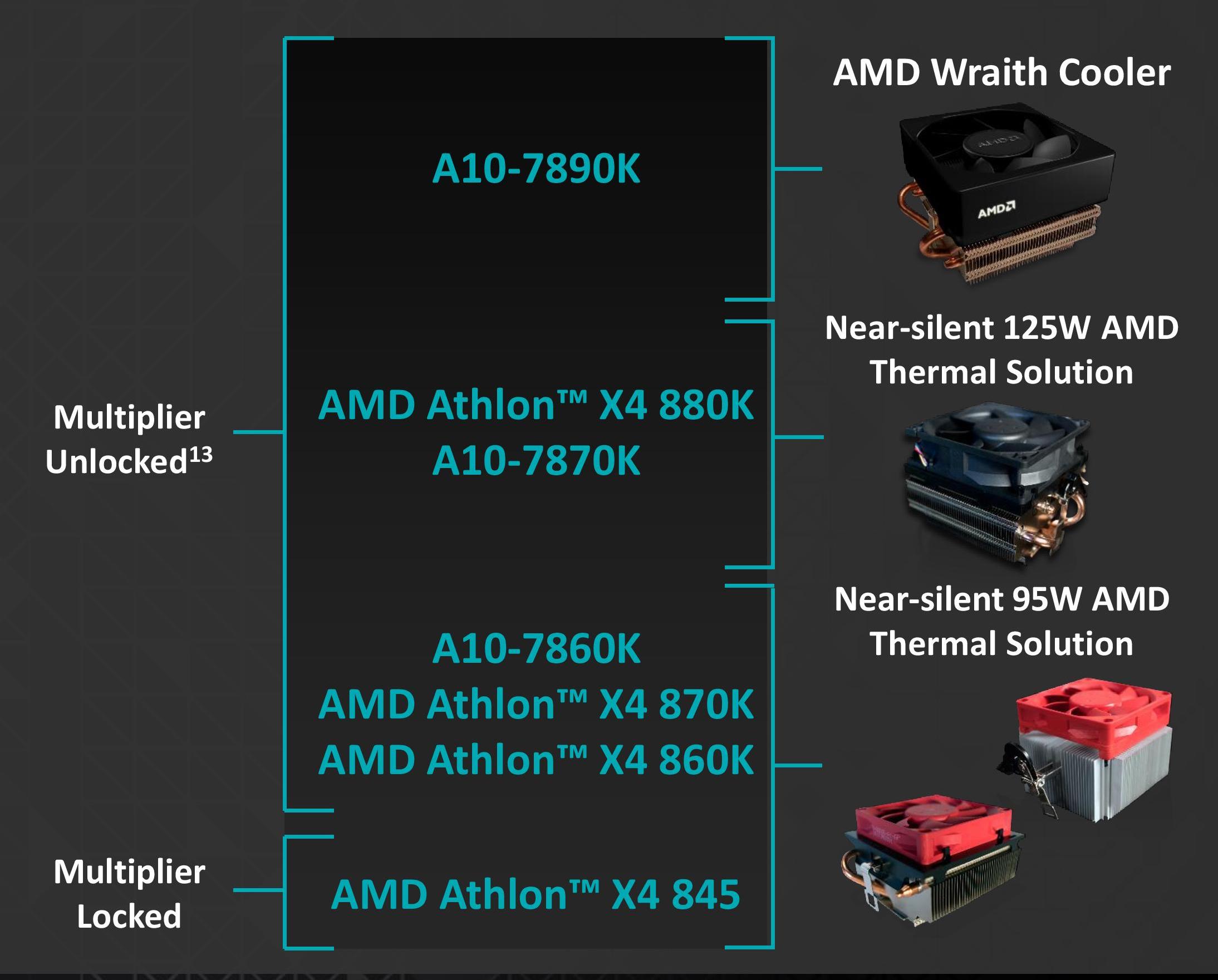
AMD's Cooler Lineup, with FX-8370 and FX-8350 also in the Wraith section
Most of their other CPUs come with the FHSA7015B, a cooler with mediocre overall performance that just gets the job done. Certain top tier models, such as the Godavari core FM2+ CPUs, come with advanced models that do offer higher overall performance and lower noise levels. The performance of these coolers may not be on par with mainstream tower coolers comparable to the Cooler Master EVO 212, but it is an upgrade comparable to buying an entry-level $15-20 tower aftermarket cooler and meeting the EVO half-way, in a sense. Only the latest 125W Wraith cooler is an exception, greatly outpacing even the Cooler Master HK8-00005 and AMD AV-Z7UB408003, coolers that were or are being supplied with other top tier CPUs.
Conclusion: AMD's Wraith is a Great Free $30 Upgrade
It's clear from the market that AMD is taking a broader interest in coolers recently, whereas Intel has taken a different direction with the new Skylake-K CPUs being sold without stock coolers. It creates an interesting platform where a good cooler might add to the cost of a processor, whereas the high performing CPUs remove their stock coolers to become more price competitive (even if you have to spend another $30 to get a cooler anyway).
But naturally, our conclusion is going to be dominated by the top performers of this roundup - the Intel BXTS15A, the AMD Wraith and the Cooler Master EVO 212.
AMD is supplying the Wraith for free alongside their top tier CPUs and it proved itself capable of performance comparable to that of a reputable mainstream cooler such as the Cooler Master EVO 212. The Wraith’s high thermal performance can be attributed to the strong 90 mm fan and heatpiped design. This saves the average user from spending a significant monetary sum for a good, silent cooler, as the Wraith is more than enough for everyday use and even for reasonable overclocking. For those that are interested, the AMD side lights up when powered as well.
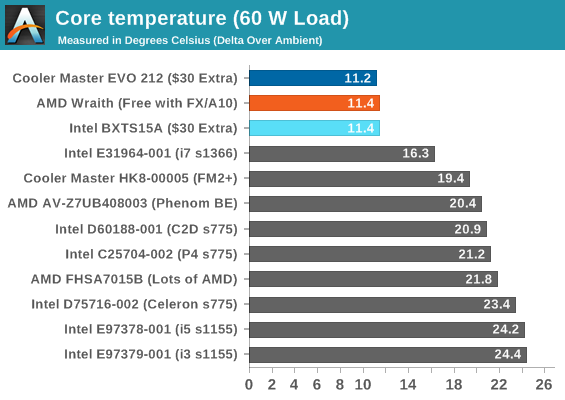
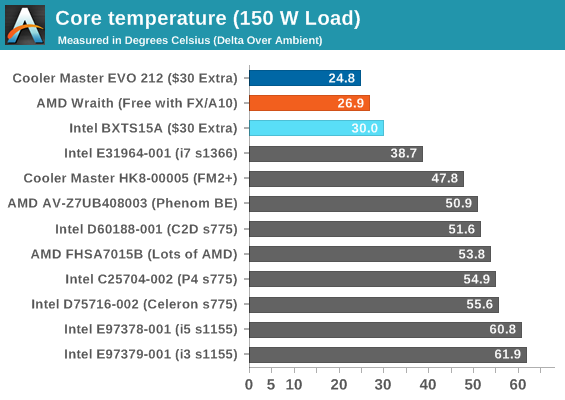
Intel supplies the BXTS15A as an aftermarket cooler, an upgrade over the stock coolers supplied alongside their CPUs. However, it hardly makes sense as an upgrade. There are several better aftermarket CPU coolers better than the BXTS15A with the same price tag, including the Cooler Master EVO 212 that was showcased in this review.
Most of Intel's CPU coolers are rated as 'good enough' for the platforms they target. However, there is no guarantee of long-term stability (note, dust) and we can see that audible performance when pushing a CPU can be excessive. If the BXTS15A was being supplied alongside a CPU then it could prevent some users from upgrading to better coolers, or it could be a viable option if it was selling for less than $20, but has little to no market value as a standalone product at such a retail price. If there are no space constraints or other mechanical issues (mounting security/strength, portability, etc.), then the recommendation is that a user bypasses the BXTS15A and moves straight on to something like the Cooler Master EVO 212 or other comparable aftermarket cooler.
A side note about noise:
It is rather ironic that both AMD and Intel are marketing their best coolers as “quiet” models, as they were among the loudest that we have tested here today when their fans were forced to operate at absolute maximum speed. AMD has stated that the Wraith 'shroud' over the top of the cooler is a few db louder (due to vibrations) than the near-silent variant, but affords additional lighting to show off the system. The catch with both the AMD and Intel solutions is that both of these coolers will actually be quiet when they replace the louder stock coolers that CPUs usually ship with, especially the smaller heatsinks of the cheaper models, although the Intel variant is an extra outlay. If the Wraith or the BXTS15A are installed on a stock CPU, their mass is enough to keep the CPU cool without relying much on airflow, allowing the thermal control of the motherboard to keep the fan’s speed (and noise) very low. It comes down to the cost of such a difference.
Cooling performance can change quickly if the CPU is constantly under heavy stress and/or overclocked, as the thermal losses of the CPU multiply under such conditions. Both companies obviously wanted to ensure that their top end coolers can hold the processors cool enough even under such conditions and thus they are using very strong fans that can provide high levels of airflow if needed. Ultimately the best way to increase airflow in these situations is with larger fans that run slower (such as the EVO), but this can be difficult when staying within specifications or having to design basic coolers to a price point without taking a loss.


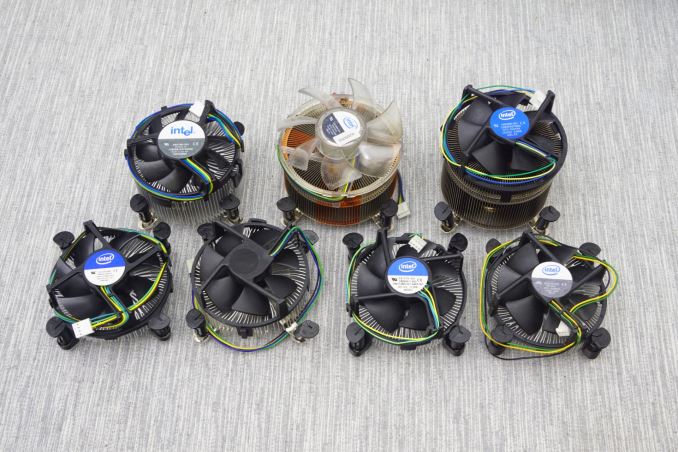

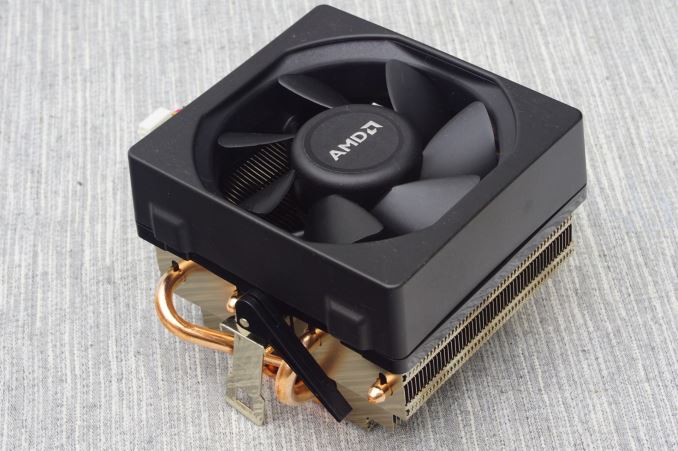









82 Comments
View All Comments
SetiroN - Friday, July 22, 2016 - link
Such a useful comparison!Let's see which other stock cooler that you will never get to replace your own stock cooler would be better.
/s
SetiroN - Friday, July 22, 2016 - link
I mean seriously, the massive marketing campaign AMD has been doing for this wraith cooler is the epitome of their lack of R&D investments. Makes me so stupidly sad.JoeyJoJo123 - Friday, July 22, 2016 - link
Makes you stupidly sad that they bundle the best stock cpu cooler out of any released ever? Why?It's a cooler that I wouldn't be shamed to choose not to get an aftermarket HSF for, as it's basically just as good as one, and it's one of the only things they can do to get people interested in their CPUs, as they know and you know and I know that their CPUs would be lackluster until Zen potentially comes out with potentially competitive value against Intel CPUs. In other words, they know they're stuck shipping slow CPUs right now, but the least they know they can do is bundle in a pretty neat stock cooler, and that might be enough to sway some buyers in their favor, which isn't a terrible thing, as AMD's already struggling to stay afloat.
SetiroN - Friday, July 22, 2016 - link
How much energy they have to put into marketing their stock cooler makes me sad, yes, because at this point it's the best part of the bundle.When a once great CPU manufacturer has to tell their customers that their CPU is better because... it has a better cooler, I think of the moment I first saw a K7 and tear up a little.
looncraz - Friday, July 22, 2016 - link
AMD hasn't put a lot of energy in at all, they made the cooler, they made a quick video, uploaded it, and everyone else did most of the work. Beyond that, they just list it as a value-add - and it is a very good value-add, indeed.close - Monday, July 25, 2016 - link
Ignore him. He's a troll and not even a very good one. I bet he was hoping for some kind of support. He'll keep repeating the same "the best thing a CPU manufacturer's got going is their bundled cooler" because he somehow thinks that backing out from this stupid statement will make him look even dumber in other people's eyes than keeping it up.nathanddrews - Friday, July 22, 2016 - link
Eh? The AMD Wraith is clearly a kickass stock cooler. I, for one, welcome the opportunity to not need to buy additional bulky HSFs. I've got 212s on most of my PCs. It's nice to know that I don't need to for an FX build.AS118 - Saturday, July 23, 2016 - link
I agree. I can't say this enough, the Wraith is pretty much a 212 in terms of performance yet it is SO easy to install. Don't even have to put on a custom backplate. I really hope Zen CPU's have the Wraith or something similar.I'd never have to buy another 212 again if AMD keeps making these. (As long as I was buying an AMD CPU that had one)
Samus - Sunday, July 24, 2016 - link
Personally I like the direction Intel went in, by not including a cooler at all and reducing the price of the CPU accordingly ($10-$20 vs Haswell)TheinsanegamerN - Wednesday, July 27, 2016 - link
the 6700k is $10 more then a devil's canyon 4790k. The price went UP, not down.